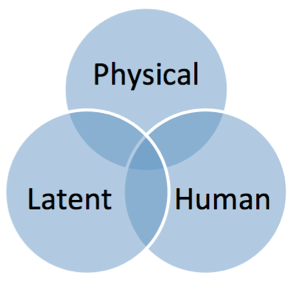This post is based on an article from the November/December 2013 issue of Inspectioneering Journal by By Fernando Vicente at ABB. You can find the original article here.
Service failures and safety incidents of machines, structures, and pressure equipment have been experienced in the oil and gas industry for many years without warning, with varying degrees of consequential damages to health, safety, environmental, business, and reputation. Unfortunately, equipment failures will occur no matter how effective a plant’s reliability program is. Not all failures are catastrophic. Many failures involve a gradual degradation of properties or excessive deformation or wear until the component is no longer functional, long before its design life is reached. Failures due to wear or general corrosive attack are not usually spectacular failures, but account for tremendous material losses and downtime every year.

Levels or root causes of failures.
All failures deserve the attention of the investigator because they reduce production efficiency, waste valuable materials, and increase costs. In some instances, they cause considerable damage or personal injury. For this reason, a good failure analysis program should be implemented at sites to understand the root cause of problems, avoid the recurrence of issues, and reduce the cost of unreliability. With an understanding of failures and their causes, technical remedies can be incorporated at various stages, and thus, the recurrence of failures can usually be prevented.
Failure Analysis and Incident Investigation should be part of all Asset Integrity Management (AIM) programs. They involve the process of studying and analyzing the failure of equipment in order to better avoid the recurrence of issues that led to the failure in the first place. The success of failure analysis depends on the use of proper analytical techniques in proper sequence. This post discusses the process of performing failure analysis and the benefits that can be realized from a well-implemented failure analysis procedure.
What is Failure Analysis?
There are several definitions for failure analysis, but it is typically defined as “the process of interpreting the features of a deteriorated system or component to determine why it no longer performs the intended function.” The failure analysis process involves first using deductive logic to find the mechanical and human root causes of the problem, and then using inductive logic to find the latent (most commonly organizational) causes. Finally, an engineering solution should be determined and lead to the changes needed to prevent the recurrence of the failure, or at least mitigate the damage caused by future incidents.
Failure analysis is a process that should be present in every high quality reliability maintenance program. Some of the benefits that can be obtained from this process include recurring problem prevention, hidden failure mechanism identification, and learning valuable lessons from past incidents and accidents. It would be nice if there were only one cause per failure, because correcting the problem would then be easy. Unfortunately, in reality, there are often multiple causes to every equipment failure.
Methodology for Failure Analysis
If the failure was one that had the probability to result in a serious incident, but did not, e.g. it could have resulted in an accident with catastrophic consequence, then the event requires a deeper failure analysis investigation. The typical steps in the failure analysis investigation should include:
- Diagnosing the failure
- Collecting background data
- Examining surfaces under low power magnification
- Deeper failure analysis on the critical pieces
- Determining the physical failure mechanisms
- Determining the other root causes
Diagnosing the failure
Visual examination with documentation is a very important first step in failure analysis and critical to diagnosing the failure. If performed thoroughly and carefully, some failures can be “solved” by visual examination, and for most failures, visual examination will dictate the subsequent steps in the analysis. The result of poor visual examination however, may be that the investigation tracks down a dead end or the analyst arrives at an incorrect conclusion.
Collecting Background Data
The investigator must develop a complete case history of the component, including details of the failure and information about the manufacturing history, before being able to intelligently select those tests and procedures best suited to analyze the failure. Important details of the component should be recorded, including: location, name of the component, identifying numbers, owner, user, manufacturer, fabricator, function, service life at the time of failure, rating of item, operating levels, normal and abnormal loads, frequency of loading, environment, materials used, manufacturing and fabrication techniques used, strength and toughness, heat treatment, stress relief, fabrication procedures, such as welding, adhesive joining, coatings, bolting, riveting, inspection techniques, date and time of failure, temperature, environment, extent of damage, sequence of failure, injuries, stage of operation when failure occurred, blueprints, photographs, or sketches of the failure and adjacent areas. A complete photographic register of the failed piece of equipment is strongly recommended for an effective preliminary analysis.
Low-Power Magnification Examination
Particular attention should be given to the surfaces of fractures and to the paths of cracks. The amount of information that can be obtained from examination of a fracture surface at low-power magnification is extensive. The orientation of the fracture surfaces must be consistent with the proposed mode of failure and the known loads on the failed part. Macroscopic examination can sometimes reveal the direction of crack growth and hence the origin of failure.
Deeper failure analysis on the critical pieces
In order to corroborate the type of damage mechanism that is present, metallographic, chemical, and SEM analysis should be performed. Metallographic examination provides the investigator with a good indication of the class of material involved and its structure. If abnormalities are present, these may be associated with undesirable characteristics that predisposed the component to early failure. Metallurgical analysis is often valuable in a failure analysis and extremely important in determining the cause of failures.
Conclusion
The oil and gas failure analysis process is a very important tool for any reliability maintenance program. Several benefits can be obtained from failure analysis investigation. One of the main benefits is simply avoiding making the same mistakes over and over. Quantifiable and unquantifiable savings can undoubtedly be realized from this type of analysis; learning where problems originated can assist in efforts to prevent them from arising in the first place and can pay dividends in terms of future production, safety performance, environmental protection, business success, good reputation, etc.

















Comments and Discussion
There are no comments yet.
Add a Comment
Please log in or register to participate in comments and discussions.